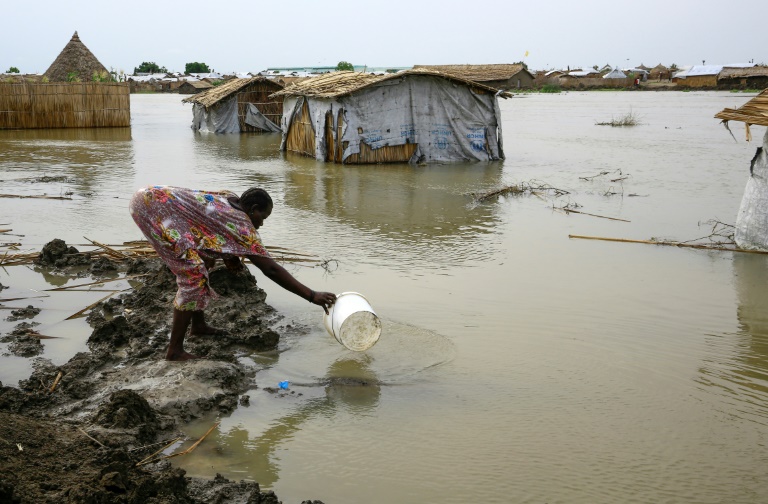Helping vulnerable nations cope with the multiplier effect of climate change on droughts, flooding, heatwaves and tropical mega-storms will require trillions of dollars, not the billions now on the table at COP26, a draft UN report obtained by AFP reveals.
The failure of rich countries to make good on a promise to deliver $100 billion a year for vulnerable nations has become a flashpoint at the UN climate talks in Glasgow, entering their final hours on Friday.
But the real cost for allowing the atmosphere to continue to heat will be far higher.
The draft Intergovernmental Panel for Climate Change (IPCC) report, scheduled for release early next year, shows that the $100 billion figure is no more than a down payment on what is needed to prepare for unavoidable impacts.
Flooded cities, food shortages, deadly heat and mass migration will all raise the price tag.
“Adaptation costs are significantly higher than previously estimated, resulting in a growing ‘adaptation finance gap’,” said an executive summary of the 4,000-page report.
“Existing governance arrangements for funding adaptation are inadequate for the anticipated scale of climate impacts.”
Earth’s surface has warmed 1.1 degrees Celsius from pre-industrial levels so far, magnifying weather extremes across the planet.
And the world is on track to surge beyond the Paris Agreement target of limiting heating to between 1.5C and 2C.
Even taking into account a new round of carbon cutting pledges this year, Earth’s surface will still warm a “catastrophic” 2.7C, the UN has calculated.
The higher the temperature rise, the higher the costs of shielding society against climate cataclysm, warns the IPCC, the world’s top climate science authority.
It says that by 2050, finance needed for adaptation could hit one trillion dollars every year, under certain emissions scenarios.
At two degrees of warming, adaptation costs in Africa alone are projected to increase by “tens of billions” every year.
– Seriously outdated –
The draft Working Group II report obtained by AFP details climate impacts and — in unprecedented detail — the rising need for adaptation.
Many scientists, including some of the report’s key authors, regret that its findings were not published before the crucial climate meet in Glasgow.
In the meantime, experts and diplomats have started to make assessments that are far greater than the figures on the table in the COP26 negotiations.
The decade-old pledge to deliver $100 billion a year by 2020 — now postponed to 2023 — was meant to help climate vulnerable countries green their economies and brace for unavoidable impacts.
But what seemed like a significant sum in 2009 looks paltry today.
“This $100 billion pledge is seriously outdated,” said Rachel Cleetus, an economist at the Union of Concerned Scientists.
“The science and the realities on the ground have overtaken what the pledge was supposed to do,” she told AFP. “When we talk about post 2025 finance it really needs to be in the trillions.”
Mohamed Adow, head of the Power Shift Africa think tank in Nairobi, told AFP that the $100 billion “doesn’t even scratch the surface of the real needs from the developing world”.
“Adaptation is a huge blind spot when it comes to dealing with the climate emergency.”
– Avoided costs –
The urgent need to fortify against climate impacts — which will be severe even with 1.5C of warming — is thrown into sharp relief by the draft IPCC report’s projections of the dollar damage rising temperatures will inflict on virtually every sector of society.
In just one low-lying city, Guangzhou in southern China, estimated losses could top a quarter of a trillion dollars a year without adaptation measures — such as massive flood defences — with an additional 20 centimetres of sea level rise.
With 2C of warming, oceans are expected to rise by nearly twice that much.
In a worst-case scenario of unabated warming, Guangzhou’s annual damages could top a trillion dollars. Other low-lying cities such as Mumbai — with fewer resources — would face a similar level of devastation.
Flooding will, on average, displace 2.7 million people in Africa every year by mid-century, staple crops yields will diminish along with nutritional value — raising the spectre of widespread malnutrition — and heatwaves will lower productivity and burden healthcare systems.
Finance for adaptation is best seen as an investment in avoided costs, the IPCC report says.
Spending $1.8 trillion, for example, over the next decade on early warning systems, climate-resistant infrastructure, agriculture, mangrove conservation and improving water access “can generate net benefits of $7.2 trillion” — a benefit-cost ratio of 4-to-1, it said.
“Investing in climate adaptation is a bit like getting insurance for a known event,” said Brian O’Callaghan, lead researcher on the University of Oxford’s economic recovery project and an author of the recently published UN Environment Programme Adaptation Gap report.
– ‘Shelter now’ –
Adow and others have called for an IPCC “special report” to quantify global adaptation, much as the policy advisory body has done for measuring the impacts of global warming.
“We must make as objective an assessment as possible of the costs of both adaptation and mitigation,” said Max Puig, lead negotiator from the Dominican Republic.
UNEP’s Adaptation Gap report published earlier this month said financing needs would be close to $300 billion per year in 2030, rising to $500 billion by 2050.
As COP26 got under way, the 54-strong Africa Group — supported by China, India and other large emerging economies — called on developed countries to mobilise at least $650 billion per year just for adaptation starting in 2030.
Separately, Fiji and other small island nations have proposed a “floor” of half that amount from 2025 — “in order to unlock lasting solutions,” Aiyaz Sayed-Khaiyum, the island nation’s minister for economy and climate change, told AFP at COP26.
Rich nations must recognise the urgency, and the inadequacy of a piecemeal solution, he said.
“You can’t build a house one wall per decade and expect it to serve as a shelter — we need shelter now.”









